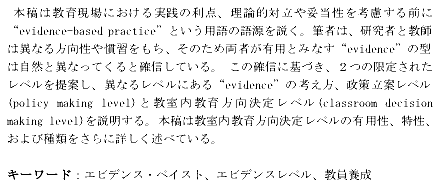|
Abstract
This article explains the origin of the term evidence-based practice before considering the benefits, theoretical opposition,
and appropriateness in the field of education. The author believes that researchers and teachers have different orientations and practices
and so the type of evidence each finds useful often differs. Following from this belief, the idea of different levels of evidence (LOE) is proposed and two specific levels are outlined: a policy making level and a classroom decision-making level. The article continues by expanding on the usefulness, qualities and variety of classroom decision-making evidence.
|
Keywords:
evidence-based practice, levels of evidence, narrative-based practice, educational theory

|
